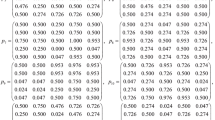Abstract
In modern enterprise management, sustainable supply chain is a concrete manifestation of the sustainable development strategy that synthetically considers serious environmental and resource problems. For sustainable supply chain, green procurement is an important component and significantly improves the environmental performance of enterprises. In green procurement, supplier selection is a critical issue. To scientifically evaluate and determine suppliers under the sustainable supply chain environment, we introduce the basic selection process of green suppliers and develop a systematic data envelopment analysis (DEA) approach that is objective and quantitative to evaluate and select green suppliers using the C2R model of the DEA method and the super-efficiency DEA model, which is based on the C2R model. We then construct a complete index system for green supplier evaluation according to environmental impact. Finally, this complete index system of green supplier evaluation and this systematic DEA approach are applied to an industrial case. Results confirm that the evaluation index system and methods are feasible, easily operated, and practically suitable for corporate use.
Similar content being viewed by others
References
Akarte MM, Surendra NV (2001) Web based casting supplier evaluation using analytical hierarchy process. J Oper Res Soc 52(5):511–522
Angell LC, Klassen RD (1999) Integrating environmental issues into the mainstream: an agenda for research in operations management. J Oper Manag 17(5):575–598
Amid A, Ghodsypour SH, O’Brien C (2006) Fuzzy multiobjective linear model for supplier selection in a supply chain. Int J Prod Econ 104(2):394–407
Amid A, Ghodsypour SH, O’Brien C (2011) A weighted max-min model for fuzzy multi-objective supplier selection in a supply chain. Int J Prod Econ 131(1):139–145
Chou S, Chang Y (2008) A decision support system for supplier selection based on a strategy-aligned fuzzy SMART approach. Expert Syst Appl 34(4):2241–2253
Cook WD, Green RH, Zhu J (2006) Dual-role factors in data envelopment analysis. IIE Trans 38(2):105–115
Cooper WW, Seiford LM, Tone K (2006) Introduction to data envelopment analysis and its uses: with DEA-solver software and references. Springer, Berlin
Dickson GW (1966) An analysis of vendor selection systems and decisions. J of Purch 2(1):5–17
Ghodsypour SH, O’Brien C (1998) A decision support system for supplier selection using an integrated analytic hierarchy process and linear programming. Int J Prod Econ 56–57:199–212
Handfield R, Walton SV, Sroufe R, Melnyk SA (2002) Applying environmental criteria to supplier assessment: a study in the application of the Analytical Hierarchy Process. Eur J Oper Res 141(1):70–87
Houshyar A, Lycth D (1992) A systematic supplier selection procedure. Comput Ind Eng 23(1–4):173–176
Kannan VR, Tan KC (2002) Supplier selection and assessment: their impact on business performance. J Supply Chain Manag 38(3):11–21
Kumar A, Jain V, Kumar S (2014) A comprehensive environment friendly approach for supplier selection. Omega 42(1):109–123
Lee A, Kang HY, Hsu CF, Hung HC (2009) A green supplier selection model for high-tech industry. Expert Syst Appl 36(4):7917–7927
Li JY, Cheng YX (2012) Total-factor energy efficiency analysis of Hebei province based on super efficiency DEA. Ind Eng J 15(1):87–92
Li ZK, Liu X (2008) Fuzzy comprehensive evaluation based on the non-ferrous metal supplier of green supply chain. Stat Decis 4:65–66
Liu B, Zhu QH (2009) Review on green purchasing practices. China Popul Resour Environ 19(1):150–155
Liu RJ, Zhang ZH (2012) Assessment on economic-environmental efficiency of China’s industry based on WTP–DEA method. China Popul Resour Environ 22(2):125–129
Liu ZF, Liu H, Song SX, Chen YD (2007) Green evaluation of suppliers based on fuzzy AHP. Mech Sci Technol Aerosp Eng 26(10):1249–1252
Lu L, Wu CH, Kuo TC (2007) Environmental principles applicable to green supplier evaluation by using multi-objective decision analysis. Int J Prod Res 45(18–19):4317–4331
Razmi J, Rafiei H, Hashemi M (2009) Designing a decision support system to evaluate and select suppliers using fuzzy analytic network process. Comput Ind Eng 57(4):1282–1290
Toloo M, Nalchigar S (2011) A new DEA method for supplier selection in presence of both cardinal and ordinal data. Expert Syst Appl 38(12):14726–14731
Wang NM, Wang YL, Yang T (2007) The research actuality and direction of green supply chain management. J Ind Eng Eng Manag 21(2):118–122
Wang YL, Wang NM, Sun LY (2003) The basic principles of green supply chain management. Eng Sci 5(11):82–87
Weber CA (1996) A data envelopment analysis approach to measuring vendor performance. Supply Chain Manag Int J 1(1):28–39
Weber CA, Current JR, Benton WC (1991) Vendor selection criteria and methods. Eur J Oper Res 50(1):2–18
Wu ZH, Pagell M (2011) Balancing priorities: decision-making in sustainable supply chain management. J Oper Manag 29(6):577–590
Zhang Z, Lei J, Cao N, To K, Ng K (2003) Evolution of supplier selection criteria and methods. Eur J Oper Res 4(1):335–342
Zheng LL (2008) The study of vendor selection strategic based on the green supply chain management. Ph.D. Thesis, Anhui Agricultural University
Zhou RX, Ma X, Li SR, Li J (2012) The green supplier selection method of chemical industry based on ANP–RBF neural network. Oper Res Manag Sci 21(1):212–219
Zhu J (2001) Super-efficiency and DEA sensitivity analysis. Eur J Oper Res 129(2):443–455
Zhu QH, Sarkis J (2004) Relationships between operational practices and performance among early adopters of green supply chain management practices in Chinese manufacturing enterprises. J Oper Manag 22(3):265–289
Zhu QH, Zhao QH (2005) A review on the study of green supply chain management and corporate performance evaluation. Science Research Management 26(4):93–98
Acknowledgments
The authors thank the anonymous referees and guest editors for their valuable and helpful suggestions for the improvement of this paper. This work was supported by the Major Program Fund of the National Science Foundation of China (71090403/71090400) and the Humanities and Social Sciences Research Planning Fund Project of the Ministry of Education (11YJA630173).
Author information
Authors and Affiliations
Corresponding author
Rights and permissions
About this article
Cite this article
Shi, P., Yan, B., Shi, S. et al. A decision support system to select suppliers for a sustainable supply chain based on a systematic DEA approach. Inf Technol Manag 16, 39–49 (2015). https://doi.org/10.1007/s10799-014-0193-1
Published:
Issue Date:
DOI: https://doi.org/10.1007/s10799-014-0193-1




